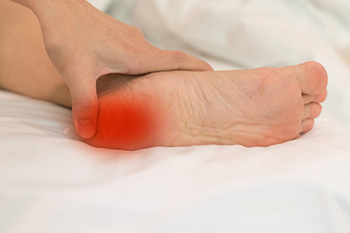
One of the most common causes of heel pain is a condition known as plantar fasciitis. This condition is caused by the straining of the ligament that runs between the toes and the heel. The straining of this ligament can produce sharp and shooting pains in the bottom of the feet that are most prominent when taking your first step after a prolonged period of rest. Many individuals are at a higher risk of suffering from plantar fasciitis. Namely, women who often wear high-heeled shoes are more prone to experiencing plantar fasciitis because of the extra strain that such footwear causes on the heel. However, it may come as a surprise to some that truck drivers are also at a greater risk of experiencing this condition. This can be explained by the fact that truck drivers spend most of their day sitting while driving, but often must suddenly and sporadically engage in physical activity during rest stops before they can properly stretch and re-engage ligaments in their feet. Truck drivers may be able to stave off the effects of plantar fasciitis by regularly stretching foot ligaments and muscles, especially before beginning to walk after a long drive. Truck drivers may also consider opting for more supportive footwear or wearing a heel cup for extra protection. Although some occupations may put individuals at a greater risk of developing plantar fasciitis, a podiatrist may be able to help create a plan to remedy and prevent this condition.
Plantar fasciitis can be very painful and inconvenient. If you are experiencing heel pain or symptoms of plantar fasciitis, contact Dr. Kenneth Donovan from Advanced Care Foot and Ankle. Our doctor can provide the care you need to keep you pain-free and on your feet.
What Is Plantar Fasciitis?
Plantar fasciitis is the inflammation of the thick band of tissue that runs along the bottom of your foot, known as the plantar fascia, and causes mild to severe heel pain.
What Causes Plantar Fasciitis?
- Excessive running
- Non-supportive shoes
- Overpronation
- Repeated stretching and tearing of the plantar fascia
How Can It Be Treated?
- Conservative measures – anti-inflammatories, ice packs, stretching exercises, physical therapy, orthotic devices
- Shockwave therapy – sound waves are sent to the affected area to facilitate healing and are usually used for chronic cases of plantar fasciitis
- Surgery – usually only used as a last resort when all else fails. The plantar fascia can be surgically detached from the heel
While very treatable, plantar fasciitis is definitely not something that should be ignored. Especially in severe cases, speaking to your doctor right away is highly recommended to avoid complications and severe heel pain. Your podiatrist can work with you to provide the appropriate treatment options tailored to your condition.
If you have any questions please feel free to contact one of our offices located in Warren, Livingston, and Toms River, NJ . We offer the newest diagnostic and treatment technologies for all your foot and ankle needs.

